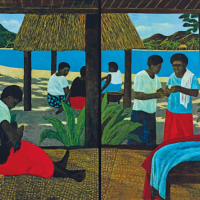29. RAY CROOKE

Ray Crooke was a significant part of the Australian art world for more than 50 years, building a career in a steady, if unspectacular, way. His work is loved and collected by many, but his contribution tends to be given only cursory recognition in the main texts and academic writings. He is either too popular, too passive, too predictable or at worst, simply too nice. His work is always calm, understandable, easy to live with and unlikely to disturb even the most timid soul. But it should be asked, why is that a problem? Does all art have to be challenging, questioning and political at heart? Must the status quo be challenged at every step with art that is harsh and aggressive and only understandable to those properly educated to understand its subtleties and deeper meanings?
Born in Melbourne in 1922, Ray Crooke began as a junior in an advertising agency, commencing work at just fifteen while studying part time at Swinburne Technical College in Hawthorn. Swinburne catered for a wide range of students, with both commercial and high art ambitions and, under its Head of Art, Louis McCubbin, assisted many young artists during the depression years, including William Dargie who would rise to the highest levels in the official art world. Ray joined the Australian Army soon after the outbreak of World War II, a daunting experience for any young man, but one which would in fact help him find his own special place in the art world. For a boy from suburban Melbourne, experiencing the islands of Northern Australia and the Pacific was a revelation, a window into a new world where he felt perfectly comfortable and at home. After his demobilisation, Crooke resumed study at Swinburne, later gaining a position there as a lecturer in the art school. His studies in design led to work in the textile industry and, while not a permanent career, it helped him develop formal ideas of design and colour which continued through a lifetime of creative work. Successful exhibitions in 1957 and 1959 helped fund a return to the north, settling on the coast just north of Cairns, where he would remain for the rest of his long career. Most in the art world came to admire his quiet, contemplative take on tropical life and he built a large following, especially once he began showing with major galleries down south. His work had a strong formal design element, with flat areas of colour and simple forms. His figures are solid and compact, always in quiet repose. There are elements of Gauguin in the exotic colour and subject matter, although most definitely without any of the erotic content central to Gauguins depictions of life in Tahiti. The interior view looking out to a tropical beach under the palms became his central theme, with subtle variations according to the scale and format of the work. It came as a surprise to many, who might have consigned him to the sidelines as a painter of unchallenging tropical domesticity, when he won the 1969 Archibald Prize for his portrait of writer George Johnson.
While most of Ray Crookes works are modest and domestic in scale, he would on occasion produce a larger, more commanding composition, such as the diptych, The Concert, Waya. Two large panels produce a striking work 2.4 metres wide, allowing almost life-sized figures, in scale appearing as a picture window onto a tropical paradise. This is emphasised by the fact that the composition itself is formed from a view from an interior looking out to a group of islanders quietly sitting about, some inside the room, some outside. The viewer, drawn in by the breadth of the painting, is encouraged to step into the picture and join them on the sand.
Gavin Fry, BA (Hons), MA, MPhil